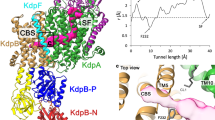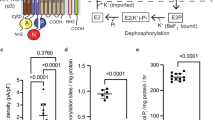Abstract
POST, Hegyvary and Kume1 found that the rate of rephosphorylation of (Na+ + K+) ATPase that had just been dephosphorylated depended on which congener of K (Rb or Li) had been used to catalyse the hydrolysis of the phosphoenzyme, even when the experiments were done in such a way that the composition of the medium during the rephosphorylation was constant. To explain the ability of the enzyme to ‘remember’ which kind of ion had catalysed the hydrolysis, they postulated that during the hydrolysis the catalysing ions became occluded within the enzyme, and were released only later after a slow conformational change. Furthermore, as ATP in high concentrations accelerated the rephosphorylation, they supposed that the slow conformational change was accelerated by the binding of ATP to a low-affinity site on the enzyme. Karlish, Yates and I.M.G.2 suggested that the hypothetical ‘occluded-K form’ of Post et al. was identical with the form of unphosphorylated (Na+ + K+) ATPase that predominates in K-containing Na-free media; they found that the conversion of that form (E2K) into the form (E1Na) that predominates in high-Na media was very slow (k ≈ 0.25 s−1 at 20 °C), and was accelerated by nucleotides acting with a low affinity and without phosphorylation. Karlish et al. also studied the conformational change in the reverse direction-E1Na→E2K—and concluded that K ions combine with the E1 form of the enzyme at sites with a relatively low affinity. They therefore suggested that the occluded-K form could be generated either following the binding of K+ ions at low-affinity sites, probably on the intracellular surface of the membrane, or by the hydrolysis of phosphoenzyme catalysed by K ions bound to high-affinity sites on the extracellular surface of the membrane2,3 (see Fig. 1). They pointed out that, if their hypothesis were correct, it could account for inward and outward movements of K ions through the sodium pump, and could explain why orthophosphate and ATP (or its non-phosphorylating analogues) are required for K–K exchange. However, the similarities between the properties of the occluded-K form and the form that predominates in K-containing, Na-free media could be coincidental. Furthermore, the idea of an occluded-K form is also open to doubt, as the experiments of Post et al. prove only that the product of the hydrolysis of phosphoenzyme differs depending on whether Rb or Li ions catalyse the hydrolysis, not that the ions become trapped inside. Both problems could be resolved if it were possible to show that, in Na-free media, K ions or Rb ions binding to the unphosphorylated form of the enzyme were indeed occluded. We report here experiments showing that they are.
This is a preview of subscription content, access via your institution
Access options
Subscribe to this journal
Receive 51 print issues and online access
$199.00 per year
only $3.90 per issue
Buy this article
- Purchase on Springer Link
- Instant access to full article PDF
Prices may be subject to local taxes which are calculated during checkout
Similar content being viewed by others
References
Post, R. L., Hegyvary, C. & Kume, S. J. biol. chem. 247, 6530–6540 (1972).
Karlish, S. J. D., Yates, D. W. & Glynn, I. M. Biochim. biophys. Acta 525, 252–264 (1978).
Glynn, I. M., Karlish, S. J. D. & Yates, D. W. in 2nd Int. Conf. Properties and Functions of No. K-ATPase (ed. Skou, J. C.) (Academic, New York, in the press).
Jørgensen, P. L. Biochim. biophys. Acta 256, 36–52 (1974).
Beaugé, L. A. & Glynn, I. M. J. J. Physiol. Lond. (in the press).
Karlish, S. J. D. & Yates, D. W. Biochim. biophys. Acta 527, 115–130 (1978).
Lowry, O. H., Rosebrough, N. U., Farr, A. L. & Randall, R. J. J. biol. Chem. 193, 265–275 (1951).
Karlish, S. J. D., Yates, D. W. & Glynn, I. M. Biochim. biophys. Acta 525, 230–251 (1978).
Author information
Authors and Affiliations
Rights and permissions
About this article
Cite this article
BEAUGÉ, L., GLYNN, I. Occlusion of K ions in the unphosphorylated sodium pump. Nature 280, 510–512 (1979). https://doi.org/10.1038/280510a0
Received:
Accepted:
Published:
Issue Date:
DOI: https://doi.org/10.1038/280510a0
This article is cited by
-
The dynamic relationships between the three events that release individual Na+ ions from the Na+/K+-ATPase
Nature Communications (2012)
-
Palytoxin Induces Functional Changes of Anion Transport in Red Blood Cells: Metabolic Impact
The Journal of Membrane Biology (2011)
-
The Identification of the Sodium Pump
Bioscience Reports (2004)
-
Three distinct and sequential steps in the release of sodium ions by the Na+/K+-ATPase
Nature (2000)
-
Simultaneous occlusion of Na+ and phosphate by the intestinal brush border membrane Na+/phosphate cotransporter
Kidney International (1996)
Comments
By submitting a comment you agree to abide by our Terms and Community Guidelines. If you find something abusive or that does not comply with our terms or guidelines please flag it as inappropriate.



